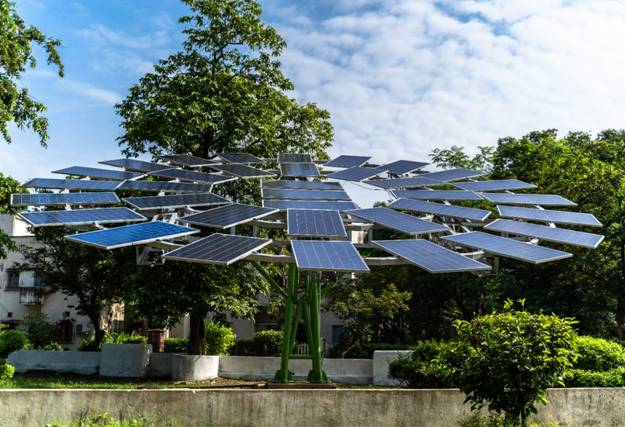The Central Mechanical Engineering Research Institute, under the Council of Scientific and Industrial Research (CSIR-CMERI), claims to have developed and installed the world’s largest solar tree.
The solar tree—installed at CSIR-CMERI Residential Colony in Durgapur—can generate above 11.5 kWp. Annually, it can generate 12,000-14,000 units of clean and green power.
The energy generation data can be monitored either in real-time or daily.
Each tree has a total of 35 solar PV panels with a capacity of 330 Wp each. The arms holding the solar panels are flexible and can be adjusted as per requirement.
The solar tree is designed to ensure maximum exposure of each solar panel to sunlight while creating the least shadow area beneath.
Potential application
These solar trees can also cater to the agricultural community’s needs in providing electricity for high-capacity water pumps, e-tractors, and e-power tillers.
Prof. (Dr) Harish Hirani explained, “The solar tree developed by CSIR-CMERI, besides being the world’s largest solar tree, has certain customizable features for application at diverse sites. The trees were designed in a manner to ensure minimal shadow area, which makes these potentially useful for widespread application in agricultural activities such as high-capacity pumps, e-tractors, and e-power tillers.”
Each solar tree can avoid 10-12 tons of CO2 emissions being released into the atmosphere as Greenhouse Gases. Besides, the surplus generated power can be fed into an energy grid.
“This agricultural model can provide a consistent economic return and help the farmers counter the effects of the uncertain variations in agriculture-related activities, thus making farming an economic and energy sustainable practice,” read a CSIR-CMERI statement.
“Each solar tree will cost Rs 7.5 lakh. The interested MSMEs can align their business model with the Pradhan Mantri Kisan Urja Suraksha evem Utthan Mahabhiyan (PM KUSUM) Scheme for farmers to develop a renewable energy-based energy grid”—it added.
Additional features
The Internet of Things (IoT)-enabled solar tree can also allow round-the-clock CCTV surveillance and precision agriculture through real-time humidity, wind speed, rainfall prediction, and soil health monitoring.
Further, these trees may be connected to solar-powered e-Suvidha Kiosks developed by CSIR-CMERI for real-time access to the vast majority of the agricultural database and the eNAM national agricultural marketplace for instant and real-time access to a unified online market.
This content is protected by copyright and may not be reused. If you want to cooperate with us and would like to reuse some of our content, please contact: editors@pv-magazine.com.









By submitting this form you agree to pv magazine using your data for the purposes of publishing your comment.
Your personal data will only be disclosed or otherwise transmitted to third parties for the purposes of spam filtering or if this is necessary for technical maintenance of the website. Any other transfer to third parties will not take place unless this is justified on the basis of applicable data protection regulations or if pv magazine is legally obliged to do so.
You may revoke this consent at any time with effect for the future, in which case your personal data will be deleted immediately. Otherwise, your data will be deleted if pv magazine has processed your request or the purpose of data storage is fulfilled.
Further information on data privacy can be found in our Data Protection Policy.